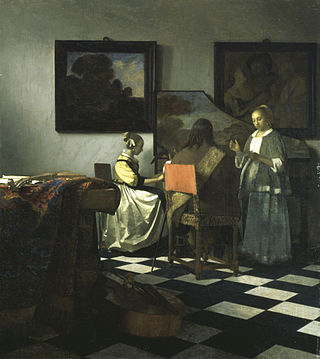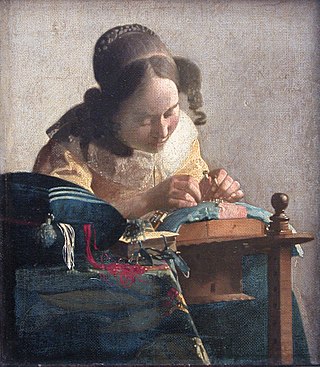
Johannes Vermeer was a Dutch painter who specialized in domestic interior scenes of middle-class life. He is considered one of the greatest painters of the Dutch Golden Age. During his lifetime, he was a moderately successful provincial genre painter, recognized in Delft and The Hague. He produced relatively few paintings, primarily earning his living as an art dealer. He was not wealthy; at his death, his wife was left in debt.

The Milkmaid, sometimes called The Kitchen Maid, is an oil-on-canvas painting of a "milkmaid", in fact, a domestic kitchen maid, by the Dutch artist Johannes Vermeer. It is in the Rijksmuseum in Amsterdam, the Netherlands, which regards it as "unquestionably one of the museum's finest attractions".

A Lady Writing a Letter is an oil on canvas painting by the 17th century Dutch painter Johannes Vermeer. It is believed to have been completed by artist during his mature phase, in the mid-to-late 1660s. The work is in the collection of the National Gallery of Art in Washington, D.C.

The Music Lesson, Woman Seated at a Virginal or A Lady at the Virginals with a Gentleman by Johannes Vermeer is a painting of a young female pupil receiving a music lesson from a man. The man's mouth is slightly agape giving the impression that he is singing along with the music that the young girl is playing. This suggests that there is a relationship between the two figures and the idea of love and music being bridged together. This was a common theme among Netherlandish art in this time period. Vermeer consistently used the same objects within his paintings such as the draped rug, the white water jug, various instruments, tiled floor and windows that convey light and shadows. This is one of few paintings produced by Vermeer which were kept in his home until his death in 1675 when his family was forced to sell them. It became a part of the Royal Collection, and it is currently on display in the Picture Gallery at Buckingham Palace in London.

Girl with a Pearl Earring is a 1999 historical novel written by Tracy Chevalier. Set in 17th-century Delft, Holland, the novel was inspired by local painter Johannes Vermeer's Girl with a Pearl Earring. Chevalier presents a fictional account of Vermeer, the model and the painting. The novel was adapted into a 2003 film of the same name and a 2008 play. In May 2020, BBC Radio 4 broadcast a new dramatisation of the novel.

The Wine Glass is an oil-on-canvas painting by Johannes Vermeer, created c. 1660, now in the Gemäldegalerie, Berlin. It portrays a seated woman and a standing man drinking in an interior setting.

The Concert is a painting by the Dutch artist Johannes Vermeer depicting a man and two women performing music. It was stolen on March 18, 1990, from the Isabella Stewart Gardner Museum in Boston and remains missing. Experts believe it may be the most valuable stolen object in the world; as of 2015, it was valued at US$250 million.

Study of a Young Woman is a painting by the Dutch artist Johannes Vermeer, completed between 1665 and 1667, and now in the Metropolitan Museum of Art, New York.

The Lacemaker is a painting by the Dutch artist Johannes Vermeer (1632–1675), completed around 1669–1670 and held in the Louvre, Paris. The work shows a young woman wearing a yellow bodice, holding up a pair of bobbins in her left hand as she carefully places a pin in the pillow on which she is making her bobbin lace.

Woman with a Lute, also known as Woman with a Lute Near a Window, is a painting created about 1662–1663 by Dutch painter Johannes Vermeer and now at the Metropolitan Museum of Art in New York.

Lady Standing at a Virginal is a genre painting created by the Dutch artist Johannes Vermeer in about 1670–1672, now in the National Gallery, London.

Officer and Laughing Girl, also known as Officer and a Laughing Girl, Officer With a Laughing Girl or, in Dutch, De Soldaat en het Lachende Meisje, is an oil painting on canvas executed ca. 1657 by the Dutch artist Johannes Vermeer. Its dimensions are 50.5 by 46 cm. It is now one of three pictures by Vermeer in The Frick Collection in New York.

A Girl Asleep, also known as A Woman Asleep, A Woman Asleep at Table, and A Maid Asleep, is a painting by the Dutch master Johannes Vermeer, created c. 1657. It is now in the Metropolitan Museum of Art in New York City and may not be lent elsewhere under the terms of the donor's bequest.

Girl Reading a Letter at an Open Window, also known as Lady reading at an open window, is an oil painting by Dutch Golden Age painter Johannes Vermeer. Completed in approximately 1657–1659, the painting is on display at the Gemäldegalerie in Dresden, which has held it since 1742. For many years, the attribution of the painting—which features a young Dutch woman reading a letter before an open window—was lost, with first Rembrandt and then Pieter de Hooch being credited for the work before it was properly identified in 1880. After World War II, the painting was briefly in possession of the Soviet Union. In 2017, tests revealed that the painting had been altered after the painter's death.
Jacob Abrahamsz. Dissius was a Dutch typographer and printer. He inherited a collection of 21 of Johannes Vermeer's works, including The Milkmaid, Portrait of a Young Woman, A Girl Asleep, Woman Holding a Balance, and The Music Lesson. In 1680, he married Magdalena, daughter and sole heir of Vermeer's main patron Maria de Knuijt, her mother, with her father Pieter van Ruijven. Dissius died in 1695, and his collection was auctioned off in Amsterdam the following year.

Woman with a Pearl Necklace by Johannes Vermeer is a Dutch Golden Age painting of about 1664. Painted in oils on canvas, Johannes Vermeer portrayed a young Dutch woman, most likely of upper-class descent, dressing herself with two yellow ribbons, pearl earrings, and a pearl necklace. As a very popular artist of the 17th century, the Dutch Golden Age, Vermeer depicted many women in similar circumstances within interior, domestic scenes. The same woman also appears in The Love Letter and A Lady Writing a Letter. The painting is part of the collection of the Gemäldegalerie in Berlin.

Mistress and Maid is an oil-on-canvas painting produced by Johannes Vermeer c. 1667. It portrays two women, a mistress and her maid, as they look over the mistress' letter. The painting displays Vermeer's preference for yellow and blue, female models, and domestic scenes. It is now in the Frick Collection in New York City.

The Guitar Player is an oil painting by Dutch Golden Age artist Johannes Vermeer (1632–1675), dated c. 1672. This work of art is one of Vermeer's final artistic activities, providing insight into the techniques he mastered and approaches to painting he favored. The painting has been on display at Kenwood House, London since the 1920s, as part of the Iveagh Bequest collection. After being recovered from a theft in 1974, when the painting was held for ransom, The Guitar Player was returned to Kenwood House.

Cardplayers in a Sunlit Room (1658) is an oil-on-canvas painting by the Dutch painter Pieter de Hooch; it is an example of Dutch Golden Age painting and is now in the Royal Collection, and on display at the King's Gallery in London.
Maria Simonsdr de Knuijt was a patron of the Dutch painter Johannes Vermeer. She provided support and financial assistance to Vermeer throughout his career. De Knuijt was married to Pieter van Ruijven, a wealthy citizen of Delft, Netherlands. Pieter had been identified as Vermeer's main patron, owning more than half of Vermeer's oeuvre. Scholarship in 2023 identified de Knuijt as the main patron, as she had known him for some time and was more directly involved with the artist. After van Ruijven and de Knuijt died, their estate was inherited by their daughter Magdalena. She died about one year after her mother, and the estate was then inherited by her husband Jacob Dissius and his father Abraham Dissius.


















